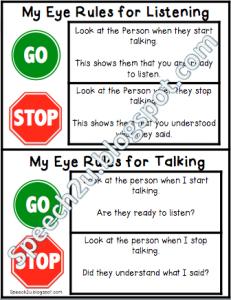Should you encourage eye contact for children on the autism spectrum?
 When I first started working as a speech language pathologist, it was common to see goals such as “Johnny will sustain eye contact for 5 minutes” or “Johnny will maintain eye contact for 90% of a conversation.” This is a great goal if your annual IEP is written to encourage Johnny to be a creepy stalker. Try this, go to the grocery store and initiate a conversation with sustained eye contact. How long did you last? I’d be surprised if you made it longer than 30 seconds.
When I first started working as a speech language pathologist, it was common to see goals such as “Johnny will sustain eye contact for 5 minutes” or “Johnny will maintain eye contact for 90% of a conversation.” This is a great goal if your annual IEP is written to encourage Johnny to be a creepy stalker. Try this, go to the grocery store and initiate a conversation with sustained eye contact. How long did you last? I’d be surprised if you made it longer than 30 seconds.
Individuals with Autism have reported that eye contact is painful. Others have said that if they are looking at you they can’t listen. I’ve thought about some of my kids on the autism spectrum as one channel processors. For instance, if they are looking at the something very visually appealing, they may not respond to our verbal overtures. They may attend to smaller details but have difficulty synthesizing everything they see and hear to come up with the whole picture.
Last year I wrote a similar post about eye contact. Since then, I’ve started to prompt my clients in a new way when they are speaking. I cue them to use a START/STOP approach with their eyes on the listener or speaker.
We try to START our verbal communication by using visually checking in with the speaker. If they need to look away while they are speaking, they are able to do that in order to compose their thoughts. When they are done with their thought-they need to visually check in again. We talk about how we need to make sure that the person understood us so we look at their face and decide if we need to reword what we said. In general this has worked pretty well. My clients are able to check in to make sure the listener is ready to receive their message and then again at the end to see if the listener has understood the message. We talk about making judgments or inferences to decide how the other person feels about what we said. Sometimes, we need to work on how long they should talk-conversations are not monologues.
We use the same START/STOP approach when we are listening. We try to check in visually when we first hear someone talking to us to let the speaker now we are listening. We use “whole body listening” strategies for them to know we are still paying attention. We check in again when they are done speaking to let them know that we understood them. You can download your copy of GO/STOP rules by clicking the above picture.
Do you work with eye contact with children on the Autism Spectrum? What are your favorite tricks? I hope you enjoyed this post. If you did, please consider sharing it with others on Pinterest or Twitter by clicking the links below.


I am not an SLP/SLT butI am a parent of a child with autism. This post helped me with my perspective of my son. I worry about (so many things including…) whether I should be trying to work on more eye contact. He does a lot of good eye contact with me when he’s trying to get my attention or telling me what he wants me to hear but when I am talking to him, he looks away. It’s good to know that might be actually helping him listen!! Thanks.
I’m glad this post was helpful for you and your son.